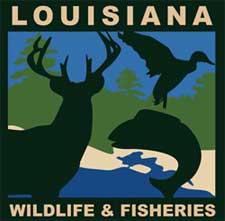

Abbeville, LA -(Ammoland.com)- Today, the Louisiana Department of Wildlife and Fisheries (LDWF) and The Conservation Fund released an innovative vision for the wild places that make Louisiana the Sportsman’s Paradise.
The 2014 Master Plan for Wildlife Management Areas and Refuges maps and evaluates every inch of the state’s rich tapestry of ecological and recreational resources – including 1.6 million acres managed by LDWF – and establishes a comprehensive strategic direction for management, future conservation, connectivity and restoration of these public lands.
“This document provides a comprehensive guide that our land managers can utilize today and for future decision making on how to best manage properties within the WMA program,” said LDWF Secretary Robert Barham. “The Conservation Fund, which assisted in this cooperative planning effort, continues to be an extremely valuable resource in our conservation mission.”
The state’s wide array of landscapes – from vast forests to remote barrier islands to immense wetlands – make Louisiana a popular destination for hunters, anglers, crabbers and nature enthusiasts alike. According to a recent report1, wildlife tourism is one of the largest industries in the Gulf region, contributing nearly $2 billion to the state economy, generating over $200 million in tax revenue and supporting approximately 82,000 jobs in Louisiana alone. Recent trends suggest an increase in Louisianans residing in metropolitan areas, with over 70 percent of the state’s population now concentrated in the cities.
These shifting populations pose a number of challenges to the state’s refuges and wildlife management areas (WMAs). Namely, the LDWF and other public land managers must accommodate this regional growth and strike a balance between enhancing public access to a variety of outdoor experiences while addressing ecosystem needs and preventing habitat fragmentation.
“Louisiana’s beautiful and diverse landscapes, abundant hunting and fishing opportunities and unmatched biodiversity attract residents and visitors alike to experience nature in a variety of ways,” said Ole Amundsen, program manager of strategic conservation at The Conservation Fund. “With states across the country looking for efficient and economical ways to balance natural resource stewardship and public needs, the LDWF recognized that it needed be able to invest smartly when deciding what lands to protect, how to manage them successfully and how to encourage the next generation to get out and enjoy its renowned natural wonders.”
The new master plan will guide the LDWF in these efforts by providing an informed and proactive vision that addresses specific landscape scale conservation goals. For the first time, the plan provides comprehensive descriptions of each and every one of the Department’s 62 WMAs and refuges, highlighting current public uses, opportunities for ecological research and future threats and needs. This valuable data will provide a framework for the development of site level management plans for each location that will be completed by the LDWF within the next three years.
In addition, the plan establishes strategic project selection criteria for future land acquisition decisions that focus on treating landowners fairly and using public funds wisely.
“The department’s WMA Program was created to manage the habitat on public-accessible properties for the various wildlife and fisheries resources contained within each and to provide outdoor recreation opportunities, both consumptive and non-consumptive, for our citizens and those visiting Louisiana,” said Jimmy Anthony, assistant secretary, LDWF Office of Wildlife. “The number of WMAs has grown through the years to the extent that a comprehensive planning document was needed.”
Over the past 20 years, The Conservation Fund and its partners have protected more than 205,000 acres across Louisiana, including approximately 160,000 acres of coastal forests and wetlands within the Lake Maurepas and Lake Pontchartrain Basin, connecting the Joyce, Manchac and Maurepas Swamp WMAs. The new plan builds on the state’s commitment to land conservation by providing a strategic framework to guide land conservation decisions and future growth. The impetus for the plan emerged in 2009, when the state legislature directed the LDWF to evaluate its existing land portfolio and develop comprehensive acquisition and management plans.
With a long track record of successful land conservation projects together, the LDWF turned to the Fund to lead the development of the master plan.
To create the plan, the Fund inventoried and evaluated the state’s natural areas to develop a statewide green infrastructure network – linking Wildlife Management Areas, Refuges and other public lands. The network is based on the latest peer reviewed science and benefitted from the input of LDWF field staff. The Fund examined the portfolio of existing LDWF lands and found several key gaps. Reconnecting urban areas with wildlife and corridors to make existing WMAs less isolated was an overarching theme that developed out of the planning process.
The Fund also assessed existing federal, state and private sector financing sources and implementation strategies to provide guidance on next steps for the LDWF. To read the full master plan document, go to: http://www.wlf.louisiana.gov/wma.
- “Wildlife Tourism and the Gulf Coast Economy,” Economic study released by Datu Research LLC, funded by Environmental Defense Fund and Walton Family Foundation, July 2013.
About the Louisiana Department of Wildlife and Fisheries
The Department of Wildlife and Fisheries is charged with managing and protecting Louisiana’s abundant natural resources. For more information, visit us at www.wlf.louisiana.gov on Facebook at www.facebook.com/ldwffb or follow us on Twitter@LDWF.
About The Conservation Fund
At The Conservation Fund, we combine a passion for conservation with an entrepreneurial spirit to protect your favorite places before they become just a memory. A hallmark of our work is our deep, unwavering understanding that for conservation solutions to last, they need to make economic sense. Top-ranked, we have protected more than 7 million acres across America.
